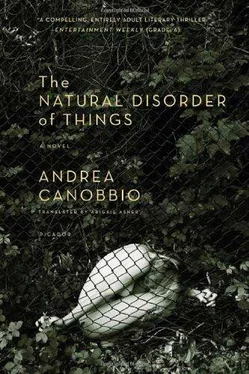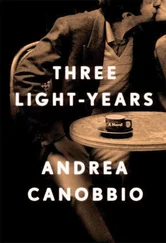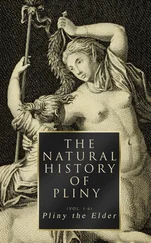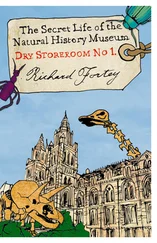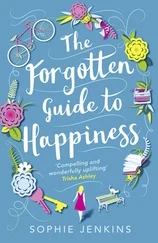I took her hair in my fist and pulled it gently, forcing her head back. I kissed her. I felt her tongue slide around mine. I wished that I had a new life, with a kiss like that every evening. It seemed like a simple wish that could easily come true.
That Thursday night, Elisabetta went home again, but on Friday she was back, and for the first time she stayed the whole night, and Saturday, and until Sunday morning. She told Alberto she was going to visit her aunts up at the lake. She wanted to hide the Ka under a tarp in case someone came around here looking for her; I told her it was useless because anybody who might be following her regularly would already know she was here, but I pulled out an old camouflage tarp anyway, one that I covered the R4 with whenever I spent a few days away from home, in case any savvy vintage-car collector commissioned someone to steal it.
We didn’t leave the house for thirty-six hours; we didn’t even open the shutters, and when we weren’t in bed we left the rooms dimly lit, and when moving from kitchen to living room, we crossed the few shafts of light that slanted through the shutters; in the whirling dust her hips and back were tiger-striped by the sun.
Sunday morning, in a corner of the living room, Elisabetta found the pile of fairy tales from the Tales Told series; I had recently seen a display of the same series I had as a kid (rereleased on tape, with the accompanying picture booklets), and I’d bought them for the boys. She and I reminisced about hearing the tales on the record player, on 45 rpm records, and then we listened to “Bluebeard” and “Snow White” and “Puss in Boots,” which both of us remembered perfectly, especially the musical breaks, the jazzy rhythms, and the funny rhymes: “Little Red Riding Hood, head as hard as a block of wood”; “My love is growing day by day: let’s get married right away”; “Jewels and gems! Gimme dese, dose, and dems.”
She had inherited the tales from an older cousin, the original 1966 edition, published when I was six, Carlo was nine, and she, Elisabetta, wasn’t yet born. At one point she asked me which one was my tale — which one told the story of my life. I told her that I didn’t know, that I hadn’t ever identified with any character.
“That’s impossible,” she said. “You must have done it, but you just don’t remember.”
“And how about you?”
Hers was “Sleeping Beauty.”
Her father was a successful accounting professional who had started his own firm. This was a big deal, and his son was supposed to carry on after him, naturally; there has to be a succession, there has to be a king or, at worst, a queen.
She had grown up with four women. The good fairies were her mother and the two aunts who lived right next door. There was a connecting door between them that was always left open, as if it were all one big apartment; she never had a sense that there was any border between their lives. The bad fairy was the father’s lover, who came to lunch every Sunday and spent a month with them at the seaside in the summer. She called her ma’am, and only when she was thirteen, when the lover disappeared from their lives, did she understand how the woman had been linked to her father, how much humiliation her mother had accepted, and what price the lover had paid.
The three good fairies made sure the daughter was raised to worship her father and his firm. Not because of any respect for abstract intellectual activity: the firm existed simply to produce money — money was the ultimate good as far as the father was concerned, and the three good fairies taught the girl to respect work and money. The bad fairy was very likable. The father didn’t want to leave the mother and marry her, even though the kingdom had recently begun permitting divorces, perhaps because the good fairies had threatened to steal his daughter away, and that was unthinkable. The bad fairy loved the girl, and the girl sensed it. But she was a bad fairy, and her position meant that she had to wreak vengeance on the family.
Every Sunday afternoon the girl went out with the father and the father’s lover. They would have hot cocoa, walk in the park, window-shop downtown. Wherever they were, at some point the father would suddenly need to stop by his office to fetch some forgotten papers or look over some urgent business. So then the bad fairy would take the girl into a church run by missionary priests whom she knew and teach her about loving her neighbor and about compassion for poor African children with big eyes and skinny legs. It was their secret, a secret between friends. The girl was happy to have a secret; deep inside a box of books she hid the pamphlets about life in the African missions, the minuscule carved wooden crucifixes, and the microscopic straw collages of Christmas crèches.
When the bad fairy began taking her along on Wednesday afternoons, too, the good fairies sighed in resignation. Then they got irritated. They observed that the girl was acting “strange.” When they found out about the deception and interrogated the girl, they discovered that she wanted to grow up to be a missionary nun, and they spoke to the king. The king drove the bad fairy away and decreed that all compassion, mercy, generosity, and love for one’s neighbor, as well as most of the crucifixes and crèches, be banned from the kingdom. People were to go to church only on Sunday morning, and only in a plain, bare church (it had walls of reinforced cement).
So in the era when other rich families were afraid of kidnappers and the Red Brigades, Mr. Valserra’s family was afraid of priests. Africa was a taboo topic: it was never to be mentioned, and the girl was encouraged to learn nothing about geography. Eventually the girl was encouraged to learn nothing about any subject; she changed schools several times and spent the last years of high school in one of those private diploma mills where all you had to do was pay the tuition.
By now she was eighteen; her father had had heart surgery, and the good fairies insisted that she matriculate in economics and business at university, to avoid giving him “any more grief.” Did that mean she had given him grief before?
She made new friends at the university, and one afternoon she happened to be at a charity event organized by Alfredo Renal. It turned out that not all compassion had been banned from the kingdom, and not all mercy had been destroyed. The king’s soldiers had overlooked one small scrap, which was left behind in a tall tower where no one ever ventured. And the princess got pricked by it, and fell in love, and got married without her parents’ permission. The king died of grief (or a heart attack), and the good fairies sold the firm to the king’s courtiers and withdrew to live near the lake.
“And did the bride and groom live happily ever after?”
“No — not the bride, anyway.”
“Why?”
“Because Alfredo could love humanity but not one woman, not one particular woman.”
“And the bride …?”
“The bride found a way to console herself.”
Sometimes she thought that she had woken from her long sleep, and she would say: My real life starts here, everything else has been just a dream that will slowly fade away. But it was never true. Not until last fall.
I’m sitting on the floor with my back against the sofa she’s curled up on; the Tales Told are scattered around us, and while listening to her story I’ve been leafing through the booklet that went with “The Three Musicians,” without looking up, and even now I don’t turn to face her — I don’t look her in the eyes when I ask:
“What happened last fall?”
“What happened was … A bunch of things happened … Well, to start with, I killed a man … more or less …”
I try to assume an incredulous tone — not frightened, just affectionately ironic: “You did what?”
Читать дальше
